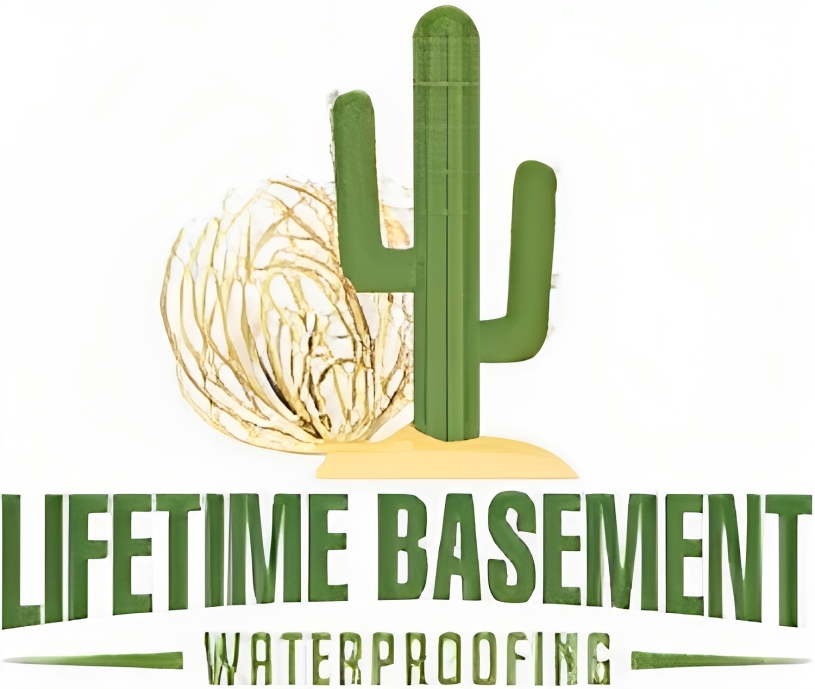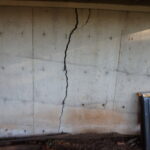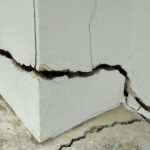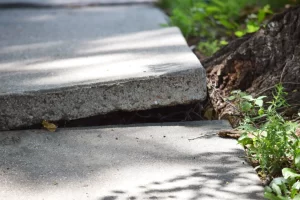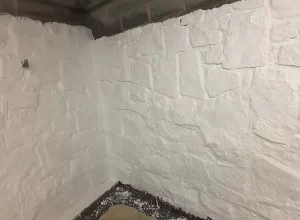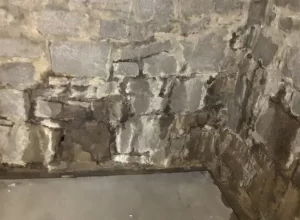
Foundation cracks happen due to several factors like soil composition, moisture levels, structural issues, natural settling, tree roots, poor drainage, extreme temperatures, and earthquakes. These elements can jeopardize the stability of your building’s foundation. Understanding these causes can help you address potential issues and maintain the structural integrity of your property.
Key Takeaways
- Soil composition affects foundation stability, with clay expanding and sandy soil shifting.
- Excess moisture weakens foundations, requiring proper drainage solutions.
- Structural issues like cracks near doors indicate foundation problems.
- Natural settling and tree roots can cause foundation cracks over time.
- Poor drainage and extreme temperatures contribute to foundation cracking.
Soil Composition
Understanding the soil composition beneath your foundation is essential in determining the causes of cracks. Different soil types react differently to changes in moisture levels and can directly impact the stability of your foundation. Clay soil, for example, is known to expand when wet and shrink when dry. This constant movement can exert pressure on your foundation, leading to cracks over time.
If your foundation is built on sandy soil, it may not provide the necessary support due to its loose and porous nature. This lack of stability can result in shifts that cause cracks to form. On the other hand, rocky soil is generally more stable but can still pose problems if there are large gaps or inconsistencies that affect the foundation’s integrity.
Identifying the specific soil composition beneath your foundation can help you address potential issues before they escalate. Conducting a soil test can provide valuable insights into the characteristics of the soil and its potential impact on your foundation. By understanding the soil composition, you can take proactive measures such as proper drainage solutions or foundation reinforcements to mitigate the risk of cracks forming in the future. Remember, a solid foundation begins with knowing what lies beneath it.
Moisture Levels
If you’re noticing cracks in your foundation, paying attention to moisture levels is vital in preventing further damage. Excess moisture around your foundation can lead to various issues that compromise its structural integrity. When the soil around your home becomes saturated with water, it exerts pressure on the foundation walls, causing them to crack over time. High moisture levels can also contribute to soil expansion, leading to heaving and uneven settlement beneath the foundation.
To manage moisture levels effectively, start by ensuring your gutters and downspouts are directing water away from the foundation. Clogged or misaligned gutters can cause water to pool near the base of your home, increasing the risk of foundation damage. Proper grading of the soil around your foundation is essential as well. The ground should slope away from the house to prevent water from collecting around the perimeter.
Consider installing a drainage system, such as French drains, to redirect excess water away from the foundation. These systems help alleviate hydrostatic pressure and prevent water from seeping into the soil surrounding your home. Additionally, maintaining proper ventilation in your basement or crawl space can help control moisture levels indoors, reducing the risk of foundation cracks caused by condensation buildup.
Structural Issues
Regularly examining your foundation for signs of structural issues is crucial to maintaining its integrity and addressing any potential problems promptly. Structural issues can lead to serious consequences if not dealt with in a timely manner. Here are some key points to keep in mind:
- Cracks in Walls: Keep an eye out for cracks in the walls of your home, especially near the corners of doors and windows. These cracks can indicate underlying structural problems that require attention.
- Uneven Floors: If you notice that your floors are sloping or uneven, it could be a sign of foundation settlement or structural damage. Addressing this issue early can prevent further complications.
- Doors and Windows Sticking: Difficulty opening or closing doors and windows can be a symptom of foundation movement. Ignoring this issue may lead to more severe structural damage over time.
Natural Settling
Keeping an eye on natural settling is essential in maintaining the structural integrity of your foundation. Natural settling occurs as the soil beneath your foundation compresses over time. When a house is first built, the soil is disturbed, causing it to shift and compact. This settling process may lead to uneven pressure on the foundation, resulting in cracks. Monitoring any signs of settling, such as uneven floors or gaps around windows and doors, is pivotal to catch any issues early on.
To address natural settling, it’s important to guarantee proper drainage around your home. Poor drainage can exacerbate settling by allowing water to pool around the foundation, increasing soil erosion and instability. Additionally, maintaining consistent moisture levels in the soil beneath your foundation can help prevent excessive settling. By keeping the soil moisture content stable, you can reduce the risk of significant shifts that may compromise your foundation’s stability.
Regularly inspecting your foundation for any signs of settling and promptly addressing them can save you from expensive repairs down the line. If you notice cracks or gaps forming, especially near corners or where walls meet, it’s crucial to consult a professional to assess the extent of the issue and recommend the appropriate measures to rectify it. Remember, early detection and intervention are key to preserving the structural integrity of your foundation.
Tree Roots
Tree roots can pose a threat to the foundation of your home as they seek out sources of water and nutrients in the soil. When these roots grow too close to your foundation, they can cause damage over time. Here are some ways in which tree roots can impact your foundation:
- Soil Dehydration: Tree roots absorb moisture from the soil, leading to soil shrinkage and causing the foundation to settle unevenly.
- Physical Pressure: As tree roots grow, they can exert significant pressure against the foundation walls, causing cracks and structural issues.
- Undermining Stability: In their search for water, tree roots can tunnel under the foundation, weakening its support and stability.
It’s important to take into account the location of trees in relation to your home and foundation. While trees provide many benefits, their roots can inadvertently harm your foundation if not managed properly. Regularly inspecting the area around your foundation for tree roots and addressing any concerns promptly can help prevent potential damage.
Poor Drainage
When dealing with tree roots near your foundation, another potential risk to take into account is essential drainage. Inadequate drainage around your home can lead to an array of problems that may ultimately result in foundation cracks. When water isn’t properly directed away from the foundation, it can accumulate in the soil surrounding your home, causing the soil to expand and contract. This constant shifting of the soil puts pressure on the foundation walls, leading to cracks over time.
To prevent poor drainage from causing foundation issues, it’s vital to confirm that your property has proper grading. The ground should slope away from the foundation to encourage water to flow away from the house. Additionally, installing gutters and downspouts can help redirect rainwater away from the foundation. Regularly cleaning and maintaining these gutters is essential to prevent blockages that could lead to water pooling near the foundation.
Another common cause of poor drainage is the lack of a proper drainage system, such as French drains or sump pumps. These systems can help collect excess water and safely redirect it away from the foundation, preventing water buildup that could compromise the structural integrity of your home.
Extreme Temperatures
Proper insulation is crucial in mitigating the impact of extreme temperatures on your foundation. Extreme temperatures, whether hot or cold, can lead to foundation cracks if not properly managed. Here are some key points to keep in mind to safeguard your foundation:
- Thermal Expansion: Changes in temperature cause materials to expand and contract. When this occurs repeatedly, it can exert stress on your foundation walls, leading to cracks over time.
- Moisture Infiltration: Fluctuating temperatures can cause moisture in the soil surrounding your foundation to freeze and thaw. This continuous cycle can weaken the foundation, making it more vulnerable to cracking.
- Differential Settling: In regions with extreme temperature variations, the ground beneath your foundation can shift due to expansion and contraction. This differential settling can result in uneven stress on the foundation, causing cracks.
To prevent foundation cracks due to extreme temperatures, make sure that your foundation is well insulated and waterproofed. Adequate drainage systems can also help regulate moisture levels around your foundation, reducing the risk of cracks. Regularly inspecting your foundation for any signs of damage and addressing them promptly can help preserve the structural integrity of your home.
Earthquakes
During seismic activity, the shifting of tectonic plates beneath the earth’s surface can exert immense pressure on your foundation, potentially causing structural damage. Earthquakes generate powerful forces that can lead to foundation cracks due to the intense shaking and ground movement they produce. When an earthquake occurs, the ground can shift and settle unevenly, causing your foundation to experience stress and strain beyond its critical limits. This sudden movement can result in cracks forming in the foundation walls or slab.
The magnitude of the earthquake and the proximity of your property to the epicenter play vital roles in determining the extent of potential damage to your foundation. Even minor earthquakes can have an impact on your foundation, especially if it’s already weakened due to poor construction or lack of maintenance. The lateral forces exerted during an earthquake can cause your foundation to shift, leading to cracks that compromise the structural integrity of your home.
To mitigate the risk of foundation cracks caused by earthquakes, reinforcing your foundation with steel rods or installing additional support systems can help increase its resistance to seismic activity. Regular inspections and maintenance can also help identify any existing issues in your foundation that need to be addressed to prevent further damage during an earthquake.
Frequently Asked Questions
Can Foundation Cracks Be Repaired Without Hiring a Professional?
You can repair foundation cracks without hiring a professional by using DIY kits available at hardware stores. Follow the instructions carefully for best results. However, for extensive damage or structural issues, consulting a professional is recommended.
How Can I Prevent Foundation Cracks From Happening in the Future?
To prevent foundation cracks in the future, make sure proper drainage away from your home, maintain consistent moisture levels in the soil, address any plumbing leaks promptly, and monitor the condition of your foundation regularly.
Are There Any Warning Signs of Foundation Cracks That I Should Be on the Lookout For?
Keep an eye out for warning signs like diagonal cracks in walls, uneven floors, or doors that stick. These can indicate potential foundation issues. If you notice any of these signs, it’s best to consult a professional.
Do Foundation Cracks Always Indicate a Serious Structural Issue With the Building?
Foundation cracks don’t always mean a serious structural problem. Sometimes, minor cracks occur due to natural settling. However, it’s important to monitor them for changes and consult a professional if you notice significant shifts or widening.
What Are Some Common Misconceptions About Foundation Cracks and Their Causes?
Foundation cracks can lead to misunderstandings. Knowing the truth about their causes is essential. Misconceptions can create unnecessary worry. Educating yourself on common myths will help you make informed decisions about your home’s foundation.
Conclusion
Lifetime Basement Waterproofing has been Atlanta’s premier basement waterproofing company for over 30 years. We’re a family-owned and operated company that specializes in basement waterproofing.
Additionally, we provide many other services at an expert level. These include crawlspace encapsulation, exterior foundation waterproofing, foundation crack repair, and drainage strategy for French drains.
You can count on Lifetime Basement Waterproofing for your wet basement repair needs. Our experienced team is dedicated to keeping your foundation strong and stable, addressing any cracks promptly to prevent further damage.
